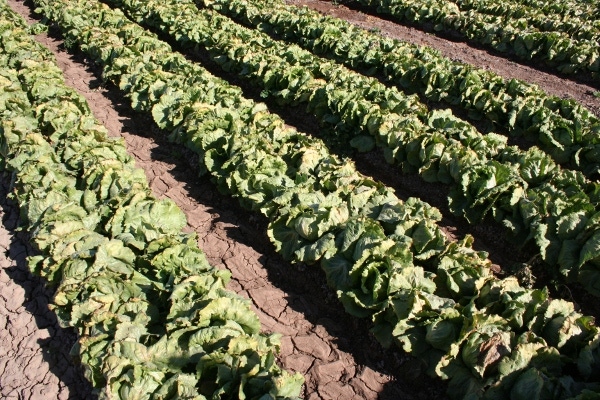
Pest control advisers should be on the lookout for leafminer insects as the first desert produce fields near harvest;Fusarium wilt and Verticillium wilt in lettuce cause internal discoloration of the root cortex and plant wilting followed by death;The key to using three pre-emergent herbicides registered in lettuce is to use the product in the right place at the right time.
November 3, 2011

The latest Arizona Vegetable Integrated Pest Management Update from the University of Arizona (UA) Cooperative Extension in Yuma, Ariz., released Nov. 1, 2011.
Leafminer management on fall lettuce
By John Palumbo, UA Research Scientist and Extension Specialist
Now that the hot weather is beginning to break in the desert and worm pressure has slowed, pest control advisers can finally take a breath and look forward to the winter and spring seasons.
It is important to not forget about leafminers, particularly as the first produce fields approach harvest. Leafminer numbers have been light to moderate so far this season, but we have recently observed high numbers (both adults, larvae and mines) on melons and lettuce at the University of Arizona (UA) Yuma Agricultural Center (YAC).
Furthermore, an increase in adult flies has been observed on yellow sticky traps used for monitoring whiteflies throughout the area over the past week or so. In most cases, the traps were located near or adjacent to fall melons, cotton, or alfalfa.
With temperatures forecast in the 70s to 80s for the next week, leafminer adult movement should subside, but larval activity could easily cause damage if left uncontrolled in lettuce or baby leaf fields where currently present.
This can cause significant damage to older, pre-harvest lettuce by feeding and damaging wrapper leaves of head lettuce and romaine. Pupae collecting within the leaf margins can also be considered contaminants.
In addition, baby leaf lettuces, spring mixes, and spinach are susceptible to larval feeding (mining) on tender growing leaves.
The good news is effective control is available with products on the market. Radiant (5-7 oz.), Coragen (5-7 oz.), and Voliam Xpress (9 oz.) applied at higher rates can effectively kill developing larvae in the leaves before causing significant damage. Similarly, Agri-Mek at 8-12 oz. can provide long residual control.
Include a penetrating adjuvant with these products to enhance larval control.
For more information on leafminer biology and management, click on this link: Insect Management: Leafminers.
Contact Palumbo: (928) 782-3836 or [email protected].
Lettuce wilt diseases
Comparison of two lettuce wilt diseases
By Mike Matheron, UA Extension Plant Pathologist
Fusarium wilt of lettuce, caused by the fungus Fusarium oxysporum, f. sp. lactucae, was first detected on lettuce in Arizona during the 2001-02 growing season. It continues to be found in lettuce fields from mid-October through early January.
There is another wilt disease of lettuce, called Verticillium wilt caused by the fungus Verticillium dahliae, which has occurred in the Salinas Valley since 1995 but has not yet been found in Arizona.
The primary symptoms of each disease are similar and consist of internal discoloration of the root cortex and plant wilting followed by death.
The internal root discoloration ranges from green, brown, and black in plants infected with Verticillium and reddish-brown to black in plants infected with Fusarium.
Since symptoms of each wilt disease are similar, true identity only can be achieved by bringing symptomatic lettuce plants to the UA’s YAC. The causal pathogen can be isolated from infected root tissue and identified by microscopic examination.
These wilt pathogens are soil inhabitants which can persist for many years. Both pathogens also can be seed-borne.
The lettuce Fusarium pathogen, Fusarium oxysporum, f. sp. lactucae, can only infect and cause disease on lettuce, although it may sustain itself on roots of other plants without initiating disease.
Verticillium dahliae, in comparison, can infect and cause disease on numerous crops other than lettuce.
Management strategies for diseases caused by Fusarium oxysporum and Verticillium dahliae are similar. Genetic resistance, when available in host crop plants, can provide effective disease control. Soil fumigation and soil solarization can reduce disease levels by lowering viable populations of both pathogens in the soil.
No known fungicides provide effective control of diseases caused by Fusarium oxysporum or Verticillium dahliae.
Contact Matheron: (928) 726-6856 or [email protected].
Kerb in lettuce
Split applications of Kerb in lettuce
By Barry Tickes, UA Area Agriculture Agent
The key to using the three pre-emergent herbicides registered in lettuce is to use the herbicide in the right place at the right time. In most cases, this is within the top one-half inch of soil when the weed seeds germinate.
Prefar and Balan stick strongly to the soil. Balan needs to be mechanically incorporated. Prefar needs plenty of water to push it into the soil.
Kerb is distinctly different. It leaches with the normal amounts of water used in the low desert and must be managed accordingly.
Widely used delayed chemigation applications are a means of accomplishing this. The timing rather than the application method is the most important.
Split applications to prolong the exposure of the weed seeds to the herbicide have been tried in recent years and recently registered for this use.
We have conducted trials with Dow Chemical to evaluate split applications of Kerb for the last few years. In one trial, a single application of 1.5 lb. produced similar control to all of the split applications except for 1.0 lb. followed by 1.0 lb. which was the best treatment. A single application made at the correct time and rate maybe the best recommendation.
Contact Tickes: (928) 580-9902 or [email protected].
You May Also Like



